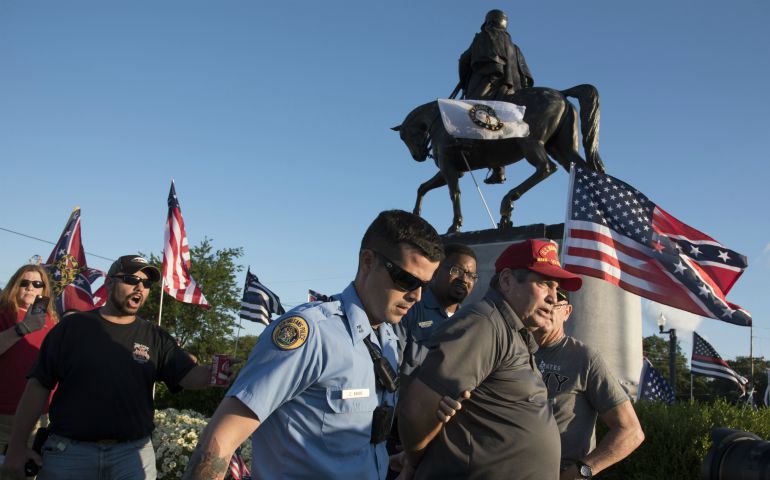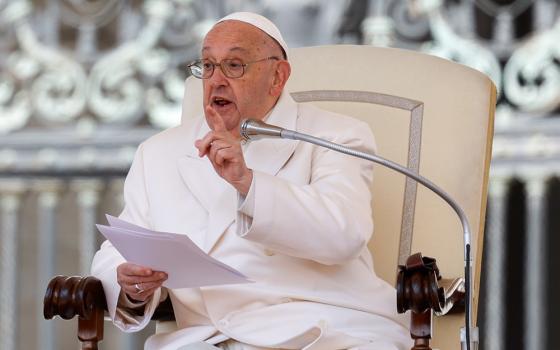
New Orleans police arrest a man after he allegedly struck a counter-demonstrator May 16 while protesting the impending removal of a statue of Confederate Gen. P.T.G. Beauregard. (Polaris/David Rae Morris)
In this sprawling city of undulated streets that lie between the Mississippi River and Lake Pontchartrain, the only traffic circle is named for Robert E. Lee. In 1884, a movement of Confederate partisans erected a 60-foot Doric column and installed an arms-folded statue of the late Confederate general, the exalted hero to a post-Reconstruction white South.
The streetcar tracks on St. Charles Avenue run several miles from the oak-draped residential streets uptown to the downtown business district, making a wide arc at Lee Circle, where crowds in the green space at the base of the monument watch parades in Carnival season.
Lee Circle was tense Friday afternoon May 19, with police, protesters and cranes in place to dismantle the statue. That morning, a photograph on Page 1 of The New Orleans Advocate featured a black man holding a rebel flag and kissing a white woman with a U.S. flag, a surreal touch of comedy in a town where debate raged for months over Mayor Mitch Landrieu's order to dismantle four monuments to the Confederacy. The mayor had 6-1 support from the majority-black City Council in 2015; preservationists and other opponents filed legal challenges, which took two years before the U.S. 5th Circuit Court of Appeals ruled that city officials had authority over city property.
At 3 p.m. May 19, before Robert E. Lee's sculptural image came down tied to crane lines, Landrieu gave a speech. His task was to explain the controversial policy, largely supported by the city's black majority, to whites and an audience beyond the room, no easy task in the deep-red South, where racial polarization runs raw in the age of Trump.
Reading from a teleprompter in pitch-perfect cadences, Landrieu spoke of the "African-American mother or father trying to explain to their fifth-grade daughter why Robert E. Lee sat atop of our city. ... Can you look into the eyes of this young girl and convince her that Robert E. Lee is there to encourage her? Do you think that she feels inspired and hopeful by that story? Do these monuments help her see her future with limitless potential? … When you look into this child's eyes is the moment when the searing truth comes into focus. This is the moment when we know what we must do, when we know what is right."
Chicago Tribune columnist Mary Schmich called it "one of the great modern speeches on history and race in America." As other commentators weighed in favorably, Landrieu's name joined the list of potential 2020 Democratic candidates for president.
He had his critics at home. In full-page newspaper ads, Frank B. Stewart Jr., the wealthy retired director of a funeral home chain, blasted the mayor for "the permanent destruction of history. ... What a dictator you've become!"
For weeks, as some social media outlets burned against Landrieu, obscene calls flooded the mayor's receptionist in City Hall. He had critics on the left, too. Malcolm Suber, a black nationalist and leader of Take 'Em Down NOLA, told NCR: "There's probably 19 to 20 other statues and hundreds of street names and still dozens of schools named for slaveholders. We want them all taken down."
That is unlikely to happen in a society jolted into debates as the city removed three other monuments — a statue of Jefferson Davis, president of the Confederacy; another of Confederate Gen. P.G.T. Beauregard; and an obelisk commemorating the 1874 insurrection by the White League, a forerunner of the Ku Klux Klan.
The City Council declared the White League monument "a public nuisance" in 1993. Beauregard was a Civil War general who after Reconstruction made efforts at racial reconciliation; the statue of the man on a horse symbolized his role in the war.
"The very ugly squabbling over the monuments has laid bare the subconscious enmity, coded bigotry and blatant racism," wrote community organizer Jacques Morial in an op-ed for the online publication The Lens.
Citing high figures in black unemployment, median income disparities and child poverty, Morial gave a begrudging "two cheers for New Orleans" on the speech and faulted "the civic and business leadership of a city more captive to tourism — an industry that thrives on low wage, no-benefit jobs and tax subsidies — than at any time in my adult life."
New Orleans has had endemic black poverty for generations. The city has a population of about 391,495 in 2016, a drop from some 484,674 people in 2000, before Hurricane Katrina scattered the population 12 years ago. According to the Data Center, the city's population in 2015 was 58.5 percent African-American, and the 2015 poverty rate was 23 percent. Orleans Parish, as civil counties are called, has the highest homicide rate of any U.S. county on per capita basis, according to a recent report.
When Landrieu stepped down as lieutenant governor to run for mayor in 2010, the city was in its fifth year of marginal recovery since Katrina; the outgoing mayor, Ray Nagin, had failed to access major lines of federal support. The police department was in disarray. Soon after leaving office, Nagin was convicted of fraud, bribery and tax evasion, earning a 10-year sentence in a federal penitentiary.
Landrieu guided a vast rebuilding of the flood-battered infrastructure, won a second term by a landslide and began looking toward 2018, when the city celebrates its tricentennial and he steps down in May, ineligible for a third consecutive term.
With a naturally outgoing personality and charisma to burn, Landrieu is also a moralist. The gun killings in scarred streets have gnawed at him for years. He makes regular visits to prisons and the local jail, arranging encounter sessions for young inmates with cops, judges and prosecutors, trying to steer men slated for parole into counseling to build coping skills.
"I don't understand why it's okay in America — a country that's supposed to be the greatest country in the world, a place with more wealth than anywhere else — for us to leave so many of our citizens basically dead," he told Jeffrey Goldberg of The Atlantic in a 2015 profile. "We have basically given up on our African-American boys. I'd be a cold son-of-a-bitch if I ignored it, if I just focused on the other side of town, or focused just on tourism."
Had he never ventured into the ideological minefield of Confederate memory, Landrieu stood well placed to preside over the city's 300th anniversary next year, and leave office as the great re-builder.
His conscience got in the way.
The Confederate statues were erected — by "the 'Cult of the Lost Cause' " in Landrieu's words — during a late-19th-century era of bloody reprisals against African-Americans, a time in which schools were re-segregated, key black leaders assassinated and black voters disenfranchised. In his May 19 speech, Landrieu tied the statues to a legacy of systemic injustice. It's hard to imagine another white politician speaking on these issues so bluntly.
"New Orleans was one of America's largest slave markets: a port where hundreds of thousands of souls were bought, sold and shipped up the Mississippi River to lives of forced labor, of misery, of rape and of torture," Landrieu said. "America was a place where nearly 4,000 of our fellow American citizens were lynched, 540 in Louisiana alone; where our courts enshrined 'separate but equal'; where Freedom Riders were beaten to a bloody pulp. So when people say to me that the monuments in question are history, well what I just described to you is our history as well, and it is a searing truth."
Political speeches typically hit hot-button issues to rouse an audience and then reach for poetic vistas of change, a new day of uplifting reform, however short on specifics. Landrieu did the opposite. He put a viewfinder on Southern history rarely discussed in white homes or taught in most schools; he turned the idea of the past upon itself.
"I want to try to gently peel from your hands the grip on a false narrative of our history that I think weakens us, and make straight a wrong turn we made many years ago — we can more closely connect with integrity to the founding principles of our nation and forge a clearer and straighter path toward a better city and more perfect union," Landrieu said.
Landrieu, 56, is like most whites raised in New Orleans who never thought much about Lee Circle, beyond its distinctive place in the urban fabric. His slant on Robert E. Lee changed several years ago over coffee with Wynton Marsalis, director of Jazz at Lincoln Center, who was home for a visit.
"That day I'd been thinking about rebuilding green spaces," Landrieu recalled in a June 9 interview at City Hall. The Central Business District, which has become a semi-residential neighborhood with offices converting to condos, is in need of greenways.
Marsalis is a year younger than Mitch Landrieu. Both are products of large Catholic families, dynasties in different fields.
Ellis Marsalis, the pianist and jazz educator, raised six sons with his wife, Delores. Three others are renowned jazzmen — Branford, Delfeayo and Jason. Wynton Marsalis went to Benjamin Franklin High School and New Orleans Center for the Creative Arts.* At 19, Marsalis recorded his first album, and his career took off like a rocket.
Moon Landrieu, who ushered blacks into city government as mayor from 1970 to 1978, raised nine children with his wife, Verna. Mitch is fifth among the siblings. His older sister, Mary Landrieu, was a three-term U.S. senator who lost a 2014 re-election bid. Another sister, Madeleine, will resign as an elected local judge at the end of June to become dean of Loyola University New Orleans College of Law, where she, Moon and Mitch earned degrees. The mayor graduated from Jesuit High School and Catholic University of America.
Seated on a couch in his office June 9, Landrieu recounted for NCR a conversation he had with Marsalis when the mayor asked for the jazz musician's help with the 2018 tricentennial. Wynton replied: "Have you ever thought about those Confederate monuments?"
"No," Landrieu answered.
"You should take 'em down," said Marsalis.
"Why?"
"Because they're offensive."
Marsalis told him that Louis Armstrong, buried in Queens in 1971, refused to visit New Orleans in his final years because of its treatment of blacks.
"My immediate thought," Landrieu said, "was I can't take them down. I told Wynton, 'I'll think about it.' " He paused. "I was wondering if the squeeze was worth the juice. I'm not looking to pick a fight with Congress or the legislature."
Asked if he consulted Moon Landrieu, hale at 86, the mayor broke into a large smile. "My dad said, 'I don't know if I'd do that' — he was talking like a father. Like a guy who's been to war, giving advice on how to avoid it."
Did he consult major supporters? "Oh yeah, all over town, and everyone said no, don't do it." Pressed to name a few, he waved off the question. "Most of them are still my friends."
He gestured to a line of thick files arranged along a wall. "That's my research. I began at the public library." In a follow-up email, he listed scholars he consulted: Creole historian Sybil Kein; Lawrence Powell, author of the esteemed local history The Accidental City; African-American historian Keith Medley; novelist Jesmyn Ward; and a pivotal figure, author Walter Isaacson, a native son who has returned to New Orleans, teaches at Tulane University and joined the New Orleans City Planning Commission under Landrieu.
"I did a lot of reading on the 'Cult of the Lost Cause,' " he continues, referring to how Southern whites treated the Civil War as a defeat for chivalry, a war never fought over slavery, but in resistance to Northern industrial progress that was steamrolling an agrarian South, good to its slaves.
"And I got it: They lost the war but they had the power. The monuments reflected that power. As I'm rebuilding the city, I want to beautify it, too. I want my city to have more traffic circles. The one we have [with the Lee statue] sent a message, we're not part of the United States. ... I adore the South, especially when confronted by Northerners who think we aren't smart and all have bad teeth."
Two years ago, when a white supremacist who dropped out of high school shot to death nine African-Americans in a Charleston church, Landrieu saw South Carolina Gov. Nikki Haley's call for the Confederate flag flying at the Statehouse to come down, and decided to make his move on the four statues.
Raymond Strother, a retired Washington, D.C., political consultant who now lives in Montana, was cheered by the impact of Landrieu's speech. Strother, who got his start in Louisiana, previously worked for Moon and Mary.
"The speech bore to the heart of the argument embraced by these Southern excusers," he said. "With so many politicians afraid of making declarative statements, he'd be refreshing as a presidential candidate. ... Mitch will be admired for his candor and courage. He is tough. I would hitch on to that bandwagon if he goes for president, and I've been on several bandwagons."
*An earlier version of this story named an incorrect high school for Wynton Marsalis.
[Jason Berry, a New Orleans author and documentary producer, is writing a history of the city for publication in 2018.]




